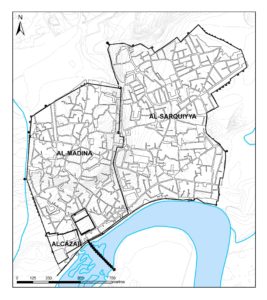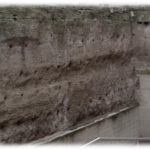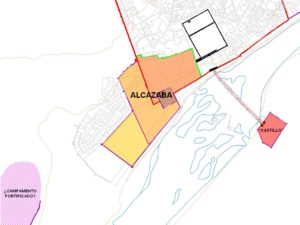
Fortifications

In the first years of the Islamic conquest the fortification of the city does not have an important role, instead other infrastructure is prioritized, such as the bridge itself, to the detriment of the materials of the walls. Throughout the Umayyad period the walled enclosure of the Medina, with about seven gates, would continue the layout of the imperial Roman city.
After the fitna and the different periods of subsequent instability, the fortifications take on greater importance. In the 11th century, part of the eastern suburbs was walled in, as shown by the excavations made in the southeast corner of the current Axerquia.

The technique would be very similar to those of the Umayyad epoch, maintaining the use of saddle and rope. Then, in the Almoravid period, it would expand to the North, to the current Ollerias Avenue, encompassing a total of about 100 hectares, and using several courses of masonry as a base for a soil and lime tapial (rammed earth) elevation.

Later, the Almohad Empire will concentrate its actions in the south-western corner of the city, protecting especially the Alcazar. The access from the south is closed around the head of the bridge with a walled enclosure of one hectare, and a large citadel is created, in tapial from the base, which triples the previous space of the Alcazar and which protects it in its western angle. These new enclosures expand the wall to the river, over the reef, eliminating the previous esplanade in front of the Alcazar. Finally, at the end of the 12th century, a large walled enclosure will be built in height, on the hill of Los Quemados, probably to accommodate the extensive Almohad army, just as the so-called Hisn al Farach (San Juan de Aznalfarache) functioned in the capital of Seville.
Bibliography
BLANCO GUZMÁN, R. (2014): “Córdoba y el califato almohade, una aproximación arqueológica”, en CRESSIER, P.; SALVATIERRA, V. (eds.): Las Navas de Tolosa, 1012-2012, Miradas Cruzadas. Universidad de Jaén, Jaén, pp. 499-508.
CORDOBA DE LA LLAVE, R., MARFIL RUIZ, P. (1995a): “Aportaciones al estudio de las murallas medievales de Córdoba. Estructura y técnicas de construcción en el Sector Ronda del Marrubial”, Meridies, 2, pp. 145-177
ESCUDERO, J.; MORENA, J.A.; VALLEJO, A.; VENTURA, A. (1999) “Las murallas de Córdoba (el proceso constructivo de los recintos desde la fundación romana hasta la Baja Edad Media)” en GARCÍA, F. R. y ACOSTA, F. (Coords.): Córdoba en la Historia: La Construcción de la Urbe. Córdoba, 201-224.
LEÓN MUÑOZ, A. (2013): “Las fortificaciones de la Córdoba Almohade”, en Isabel Cristina F. Fernandes (coord.): Fortificações e território na Península Ibérica e no Magreb (séculos VI a XVI), Lisboa, Edições Colibri/Campo Arqueológico de Mértola, vol. 1, pp. 337-354.
LEÓN, A. et alii (2004): “Informe-Memoria de la I.A .U. en el P.A. SS-4 (Entorno de la Torre de la Calahorra) (Córdoba)”, en Anuario Arqueológico de Andalucía2001, III/Actividades de urgencia, Sevilla, pp. 244-257.
LEÓN, A.; LEÓN, E. y MURILLO, J. F. (2008): “El Guadalquivir y las fortificaciones urbanas de Córdoba”, IV Congreso Internacional sobre fortificaciones: “Las Fortificaciones y el mar”, Alcalá de Guadaira (Sevilla), pp. 261-290.
LEÓN MUÑOZ, A.; MURILLO REDONDO, J. F. (2009): “El complejo civil tardoantiguo de Córdoba y su continuidad en el Alcázar omeya”, en Madrider Mitteilungen, 50, pp. 399-432.
MURILLO REDONDO, J. F. et alii (2009-2010): “Investigaciones arqueológicas en la muralla de la Huerta del Alcázar (Córdoba)”, en Anejos de Anales de Arqueología Cordobesa, 2, pp. 183-230.

